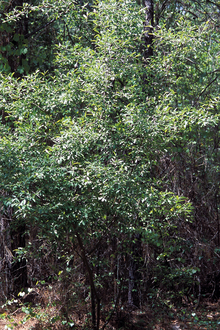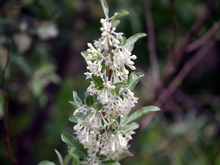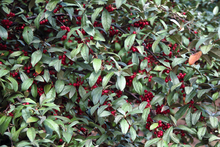Quick facts
Autumn olive is on the USDA terrestrial invasive plants list.
- Autumn olive is a nitrogen-fixing plant that changes soil chemistry and disrupts native plant communities.
- Once established it can eliminate most other plant species.
Autumn olive should be reported. The Minnesota Department of Natural Resources provides detailed recommendations for reporting invasive species.
How to identify autumn olive
- Large shrub or small deciduous tree can grow up to 20 feet tall with gray to silver foliage.
Stem
- Silvery or golden brown with speckles
- Often with thorns.
Branches
- Alternate Leaves: Simple, alternate, small, elliptical or oval, 1–3 inches long, about 1 inch wide.
- Silver-gray on underside and dark green on top.
- Have entire, wavy margins.
Flowers
- Fragrant, small (1/2 inch long), yellowish tubular flowers.
- In clusters of 5 to 10 from the leaf axil.
- Bloom from February to June.
Fruit and seeds
- Small, fleshy, round to egg shaped.
- Unripe fruit is silver-scaled and yellow, turning pink to red when ripe.
- Fruit is abundant; some plants produce up to 8 pounds of fruit in a season.
- Seeds are eaten and dispersed by birds, opossums, skunks and raccoons.
- Seed germinates readily.
Roots
- Extensive root system that reaches beyond crown.
Reviewed in 2019




